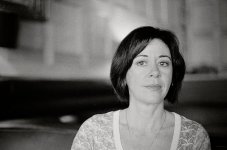I find with sharpen true B&W scans with the unsharp mask needs thought. If its grainy, I don't sharpen. This just exacerbates the grain and as it is, gain tends to provide good edge actuance anyways. Even on a good scan, in conjunction with an edge mask, I find the highest value I apply is about 80 with Radius set to 1, and Threshold set to 0. With colour, especially transparencies, with the same radius and threshold values I can usually apply between 150 ~ 200 without getting over-sharpening effects.
I also find with this scanner - using Vuescan - that locking an exposure value into an emulsion specific .ini file that can be loaded as required is beneficial. Vuescan can calculate this for you using clear film base (and they're all different). Doing this more or less anchors your black point which minimises tonal stretching on that end as you set the white point. Stretching out the white side of the histogram seems to introduce far less noticeable speckling than if done the other way around.
I use 8x sampling on the basis that each doubling of the sample rate increased the significant bit depth by 1-bit. Regardless of whether these scanners have 14- or 16-bit registers, they certainly don't capture data to that depth. For example, if a one pass scan captured 12-bits of real data, an 8x scan would extend that to 15-bits (3 doublings 2, 4, 8). As a caveat, like everyone one else I haven't actually seen a visible difference but from a theoretical perspective, I do it anyways. (I stop at 8x rather than 16x as a compromise on scan time 😀)



